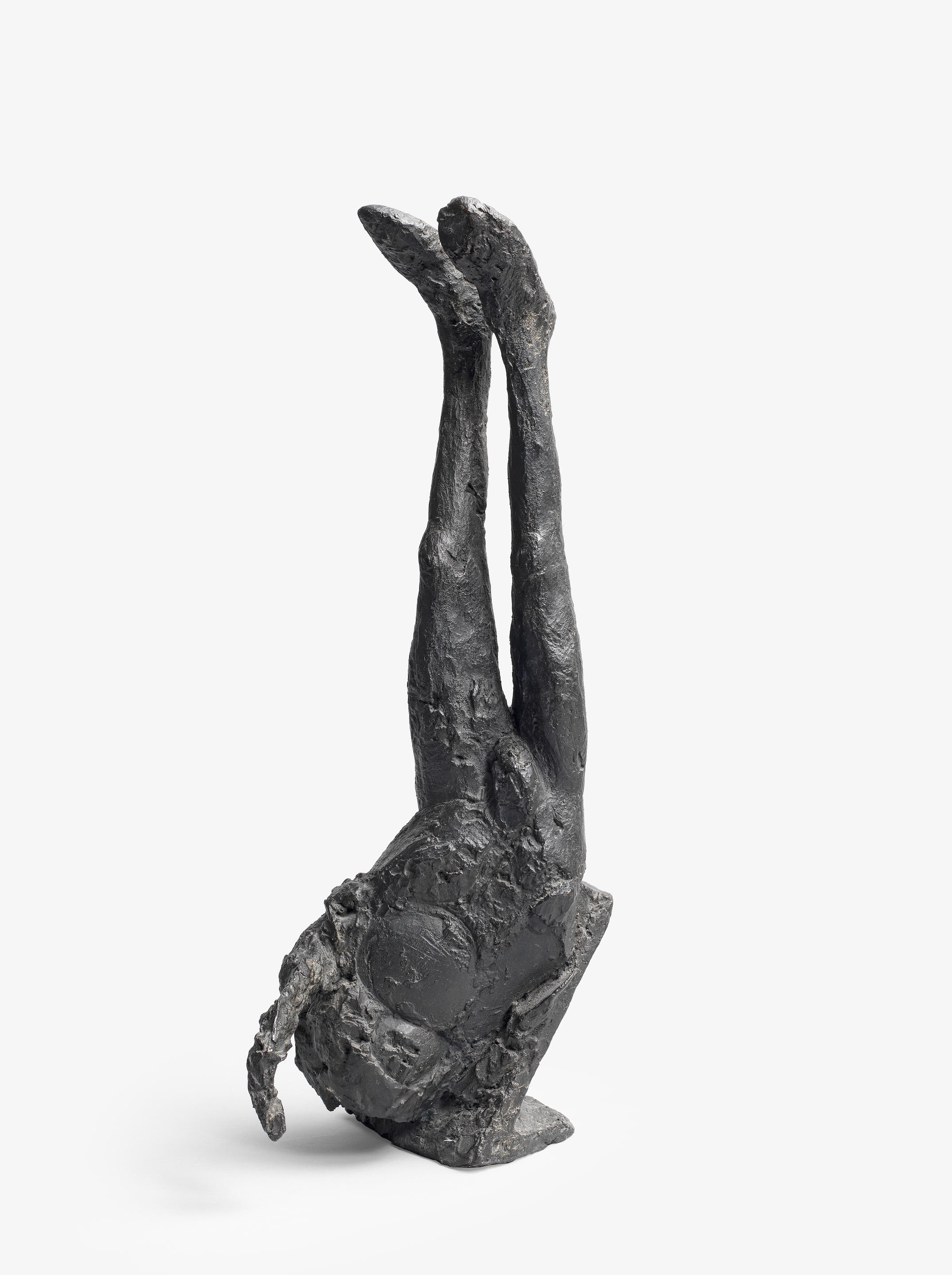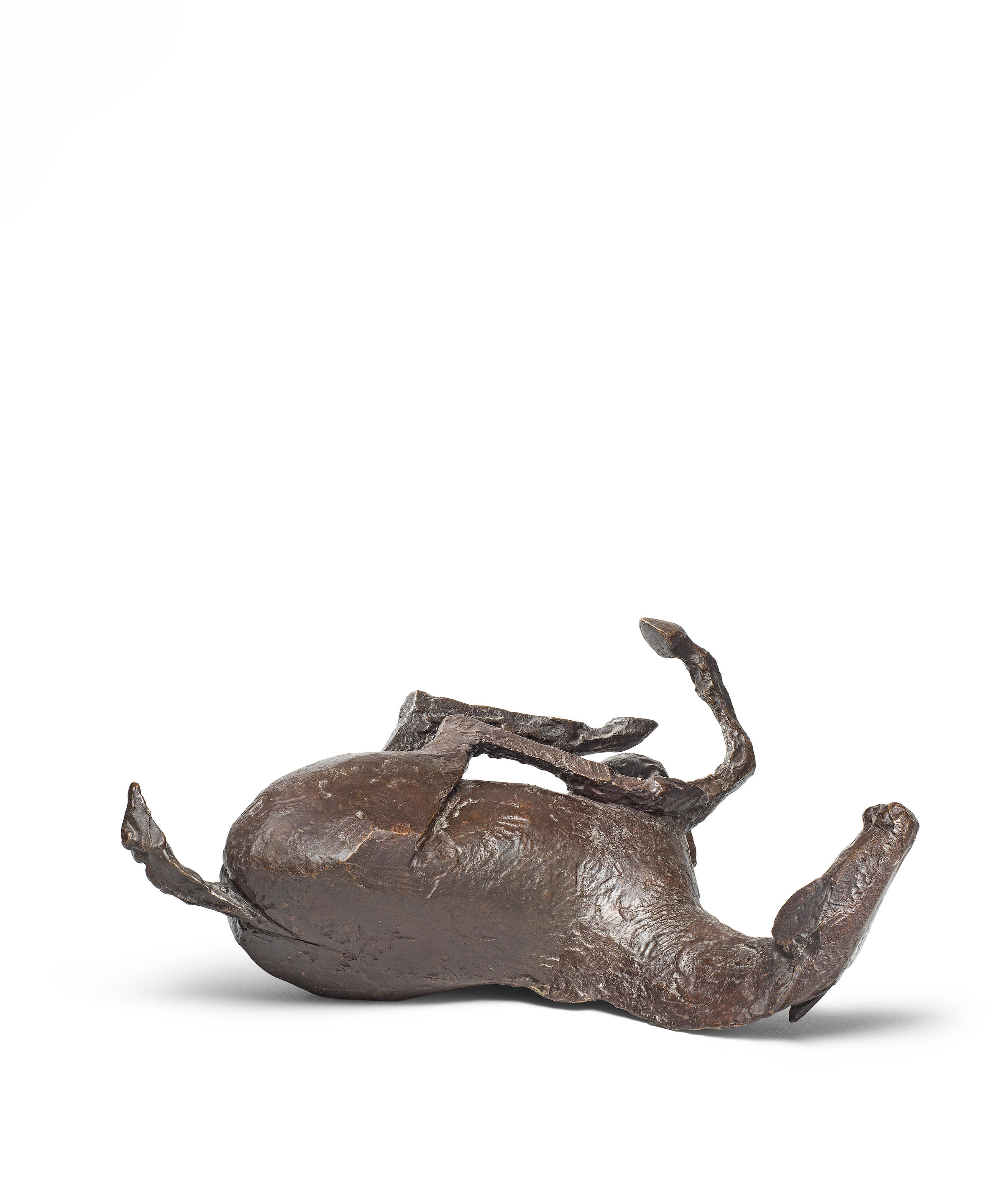Dame Elisabeth Frink R.A. (British, 1930-1993)Leonardo's Dog II
signed, inscribed and stamped with foundry mark 'Frink A/C' (on the outside of the right rear foot)
bronze with a brown patina
101.6 cm. (40 in.) high
Conceived in 1992, an Artist's Cast aside from the edition of 6FootnotesProvenance
Dame Stephanie Shirley, by whom gifted to
Paintings in Hospitals
Exhibited
Dorchester, Dorset County Museum, Elisabeth Frink: Man and the Animal World, 28 June-23 August 1997, cat.no.86 (another cast)
Literature
Edward Lucie-Smith, Elisabeth Frink: Sculpture since 1984 and Drawings, Art Books International, London, 1994, p.191 (ill.b&w, another cast)
Annette Downing, Elisabeth Frink 1930-1993, Sculptures, Graphic Works, Textiles, exh.cat., Salisbury Festival, 1997, pp.27, 71, cat.no.86 (SC58) (ill.b&w, another cast)
Annette Ratuszniak (ed.), Elisabeth Frink Catalogue Raisonné of Sculpture 1947-93, Lund Humphries in association with the Frink Estate and Beaux Arts, London, 2013, p.188, cat.no.FRC396 (ill.b&w, another cast)
'Frink's dogs are an excellent example of the way in which she managed to remain a popular, communicative artist at a time when the visual arts, sculpture in particular, were becoming increasingly esoteric.' (Edward Lucie-Smith).
It is true, as Edward Lucie-Smith comments, that Frink's large and imposing Leonardo's Dog II resembles the attractive Hungarian gun-dog breed of Vizslas; although the sculptor maintained they were not based on any one particular breed. The droopy ears, rounded nose and raised eyebrows lend the dog an inquisitiveness and friendliness which is also conveyed in her maquette for the present work. However, the author also notes:
'It would have been easy to sentimentalize subject-matter of this type, and transform it into something unbearably kitsch. It says much for Frink's talent, and for her temperament – her attitude towards the natural world – that she was able to avoid this trap. Her avoidance of it is perhaps the more remarkable considering that some dogs she depicted are scarcely out of puppyhood.' (Edward Lucie-Smith, Elisabeth Frink, Sculpture Since 1984 and Drawings, Art Books International, London, 1994, p.19).
As is often the case with Frink's animal sculptures the idea for representing the dog was established early on in her career, during the formative years of the 1950s. In one particular bronze, Blind Beggar and Dog (1957) the animal is used in a protective role, leading its helpless master forward in search of money. The dog's legs have been attenuated in much the same way as her other bronze, Dog from the same year, so that the creature takes on the appearance of something more wild, like a jackal perhaps. Revisiting the subject 35 years later this comforting idea, of protection, had not left Frink; the title of the present work was inspired by the stone dogs which guard and protect the entrance to the Chateau de Cloux near Amboise, Leonardo da Vinci's home when he died in 1519. Again, the dog is there to serve, ever faithful, but in this instance depicted in a far more domesticated fashion, one which is more accessible to the viewer and representative of the animal she is working from.
It is difficult to appreciate when looking at a photograph of Leonardo's Dog II just how solid and three-dimensional the sculpture is. There is a 'presence' and weight attached to the work which Lucie-Smith has likened to the monumentality of War Horse for Chatsworth. Only upon walking the complete way around the sculpture can the viewer engage and appreciate the power behind this alert beast. Its vaguely rendered and over-sized paws serve to fix the seated dog to its chosen location, whether indoors or outside, and the lack of modelling to the surface emphasizes the vastness of the dog.
Created in the penultimate year of her life, Leonardo's Dog II is a fitting tribute to Frink's love affair with all types of animals over a four decade long career.
Dame Elisabeth Frink R.A. (British, 1930-1993)Leonardo's Dog II
signed, inscribed and stamped with foundry mark 'Frink A/C' (on the outside of the right rear foot)
bronze with a brown patina
101.6 cm. (40 in.) high
Conceived in 1992, an Artist's Cast aside from the edition of 6FootnotesProvenance
Dame Stephanie Shirley, by whom gifted to
Paintings in Hospitals
Exhibited
Dorchester, Dorset County Museum, Elisabeth Frink: Man and the Animal World, 28 June-23 August 1997, cat.no.86 (another cast)
Literature
Edward Lucie-Smith, Elisabeth Frink: Sculpture since 1984 and Drawings, Art Books International, London, 1994, p.191 (ill.b&w, another cast)
Annette Downing, Elisabeth Frink 1930-1993, Sculptures, Graphic Works, Textiles, exh.cat., Salisbury Festival, 1997, pp.27, 71, cat.no.86 (SC58) (ill.b&w, another cast)
Annette Ratuszniak (ed.), Elisabeth Frink Catalogue Raisonné of Sculpture 1947-93, Lund Humphries in association with the Frink Estate and Beaux Arts, London, 2013, p.188, cat.no.FRC396 (ill.b&w, another cast)
'Frink's dogs are an excellent example of the way in which she managed to remain a popular, communicative artist at a time when the visual arts, sculpture in particular, were becoming increasingly esoteric.' (Edward Lucie-Smith).
It is true, as Edward Lucie-Smith comments, that Frink's large and imposing Leonardo's Dog II resembles the attractive Hungarian gun-dog breed of Vizslas; although the sculptor maintained they were not based on any one particular breed. The droopy ears, rounded nose and raised eyebrows lend the dog an inquisitiveness and friendliness which is also conveyed in her maquette for the present work. However, the author also notes:
'It would have been easy to sentimentalize subject-matter of this type, and transform it into something unbearably kitsch. It says much for Frink's talent, and for her temperament – her attitude towards the natural world – that she was able to avoid this trap. Her avoidance of it is perhaps the more remarkable considering that some dogs she depicted are scarcely out of puppyhood.' (Edward Lucie-Smith, Elisabeth Frink, Sculpture Since 1984 and Drawings, Art Books International, London, 1994, p.19).
As is often the case with Frink's animal sculptures the idea for representing the dog was established early on in her career, during the formative years of the 1950s. In one particular bronze, Blind Beggar and Dog (1957) the animal is used in a protective role, leading its helpless master forward in search of money. The dog's legs have been attenuated in much the same way as her other bronze, Dog from the same year, so that the creature takes on the appearance of something more wild, like a jackal perhaps. Revisiting the subject 35 years later this comforting idea, of protection, had not left Frink; the title of the present work was inspired by the stone dogs which guard and protect the entrance to the Chateau de Cloux near Amboise, Leonardo da Vinci's home when he died in 1519. Again, the dog is there to serve, ever faithful, but in this instance depicted in a far more domesticated fashion, one which is more accessible to the viewer and representative of the animal she is working from.
It is difficult to appreciate when looking at a photograph of Leonardo's Dog II just how solid and three-dimensional the sculpture is. There is a 'presence' and weight attached to the work which Lucie-Smith has likened to the monumentality of War Horse for Chatsworth. Only upon walking the complete way around the sculpture can the viewer engage and appreciate the power behind this alert beast. Its vaguely rendered and over-sized paws serve to fix the seated dog to its chosen location, whether indoors or outside, and the lack of modelling to the surface emphasizes the vastness of the dog.
Created in the penultimate year of her life, Leonardo's Dog II is a fitting tribute to Frink's love affair with all types of animals over a four decade long career.
.jpg)














Testen Sie LotSearch und seine Premium-Features 7 Tage - ohne Kosten!
Lassen Sie sich automatisch über neue Objekte in kommenden Auktionen benachrichtigen.
Suchauftrag anlegen